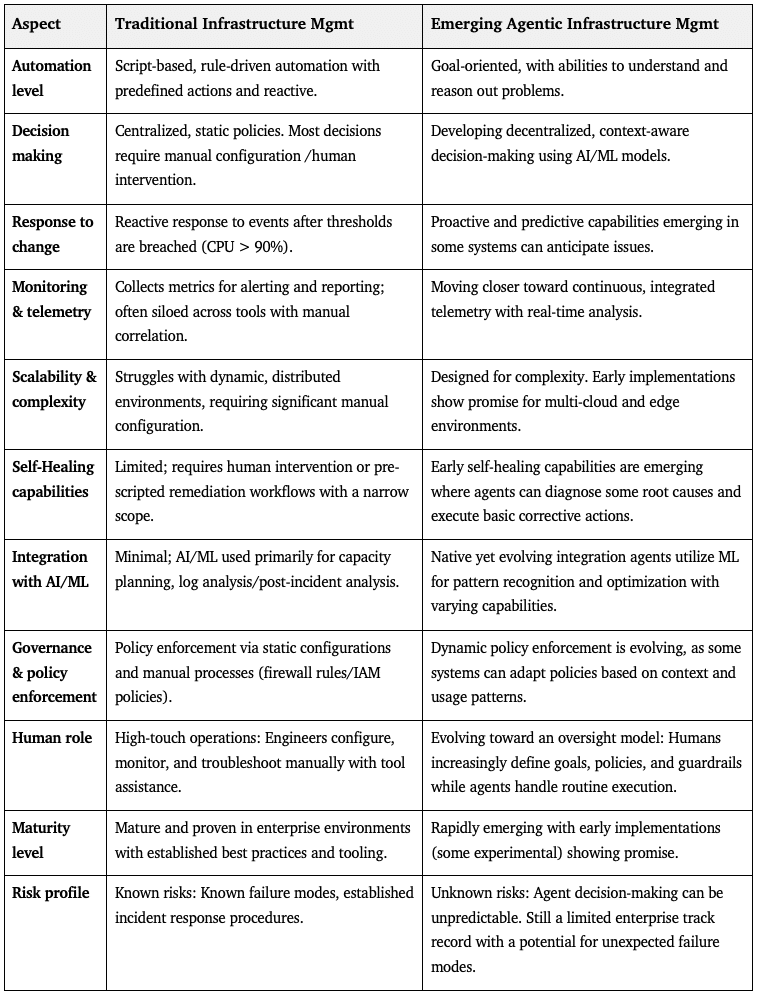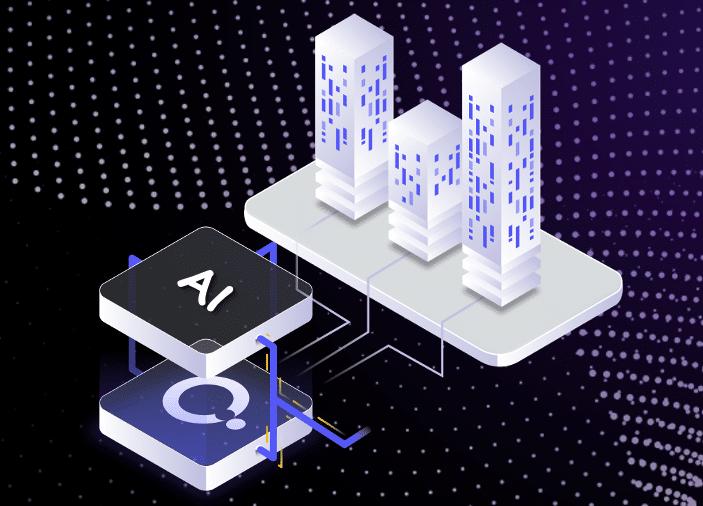Generative AI (GenAI) has had an unparalleled effect on the business landscape, across industries. Yet, approximately only two out of every 10 companies using GenAI report significant impacts on their bottom lines. Although chatbots and copilots have classed up considerably in recent years, their impact remains difficult to quantify. However, when it comes to infrastructure management, the story is a little different
GenAI is successfully delivering significant value in infrastructure management through blueprint creation, documentation automation, and workflow generation. But the automated part of this process comes to a grinding halt right about there. Although GenAI boosted individual productivity, it didn’t fundamentally change how infrastructure systems operated autonomously: Infrastructure still requires human orchestration, approval workflows, and manual intervention for complex operations.
Despite the rise of AI, that infrastructure-management model is falling short, with cloud environments growing faster than our human capacity to manage them. The solution to the problem is Agentic AI.
What Is Agentic AI?
Agentic AI is a proactive, autonomous intelligent system capable of making decisions and taking action autonomously in dynamic environments within guardrails and with minimal human intervention.
Unlike Gen AI, which is reactive and depends on prompts or detailed instructions to generate new content, this advanced form of artificial intelligence is designed to understand goals, evaluate contexts, and solve complex problems independently and in real time. For example, an AI agent may provision a Kubernetes cluster based on workload demands, enforce compliance policies, or optimize costs by decommissioning idle resources.
In a multi-agent framework, all agent activities are coordinated through AI orchestration. In this scenario, each agent takes the initiative and is responsible for a specific task that contributes to the overall goal.
Key characteristics of Agentic AI in infrastructure management include:
- Continuous monitoring across all infrastructure layers (compute, storage, network, and security).
- Evaluating multiple factors (performance, cost, compliance, and business impact) before acting.
- Proactive measure taking making changes immediately based on conditions, not waiting for manual intervention.
- Improved decision-making based on desired outcomes and environmental patterns.
How is infrastructure with agentic AI different from traditional infrastructure management?
For years, infrastructure teams have been using static templates that require human triggers, including manual drift detection and remediation. But approval-gated policy enforcement creates bottlenecks. In a fast-paced environment, reacting to incidents manually can quickly lead to performance issues or even total disruption.
Infrastructure teams can leverage agentic AI’s self-healing systems, which are capable of automatically detecting and resolving issues. We don’t have to wait for an engineer to rush back and react. Agents will also proactively monitor and optimize resources based on usage predictions, enforcing autonomous policies without human intervention.
Businesses are already starting to benefit from predictive scaling and cost management, as well as multi-agent collaboration across infrastructure domains. Platforms such as Quali Torque already support predictive scaling and cost management.
Torque is a Software-as-a-Service (SaaS) solution designed to enhance and streamline the delivery of cloud infrastructure throughout the entire lifecycle, from Day 0 to Day 2. The platform is actively working towards developing AI-driven decision-making and facilitating native coordination among multiple agents to enable collaboration across different infrastructure domains.

Figure 1. A Comparison of traditional and agentic infrastructure management
The key difference between both approaches is this: Traditional infrastructure management depends on reactive monitoring with human response and agentic AI-managed infrastructure takes predictive action with autonomous coordination.
For example, with traditional infrastructure, weekend traffic overloads trigger a cascade of events that demand developer requests, infrastructure team approvals, security coordination, and manual changes. These can quickly result in delays, ranging from 8 to 72 hours on average, as well as operational inefficiencies and costly downtime.
Autonomous infrastructure agents, however, can automatically detect usage patterns, scale resources within policy boundaries, maintain compliance, and deliver fully functional environments within 30 to 60 minutes on average, all without any human intervention.
The multi-agent architecture
This kind of autonomous coordination can only happen when specialized AI agents work together. Different agents can be responsible for specific domains, including cost optimization, security compliance, performance monitoring, and capacity planning.
Agents can also collaborate by sharing context and coordinating actions across various systems while reducing points of failure. But there is also the risk of creating new failure modes.
Platforms such as Quali Torque already have AI-driven capabilities that work together within the platform to manage the infrastructure lifecycle using specialized automation for different domains, including:
- Cost optimization
- Drift remediation
- Environment discovery
- Policy enforcement
For example, within Torque’s boundaries, discovery agents identify infrastructure resources, such as the policy engine, and automatically evaluate them against governance frameworks. To mitigate risk, proactive and real-time continuous collaboration may help prevent issues from arising, rather than just reacting to them.
Network agents, for instance, can inform security agents while cost agents can influence performance decisions (based on usage analysis), enabling cross-domain awareness. Similarly, drift detection can trigger automatic remediation workflows that respect security and compliance policies.
How GenAI and agentic AI create infrastructure synergy
GenAI and Agentic AI make a perfect combination to achieve true autonomy. Infrastructure teams can use GenAI to create blueprints, templates, generate documentation, and define policies and procedures. But as GenAI still requires human intervention, agentic AI can step in to execute, adapt intelligently in real time to optimize existing systems, and work autonomously.
As impressive as that is, agentic AI still currently lacks a creative design capability. As these technologies mature, they will provide the capabilities, remove limitations, and create conditions for infrastructure to autonomously design, deploy, and optimize itself continuously.
The Torque path forward
As alluded to above, Quali Torque is already moving toward delivering agentic infrastructure, building on GenAI to provide environments that sense changes, adapt in real time, and enforce policies without human intervention.
Torque offers sophisticated agent coordination, with a current implementation that includes:
- Reliable automation within defined boundaries.
- Policy enforcement that scales with organizational complexity.
- Gradual expansion of autonomous decision-making as confidence grows.
- Integration patterns that work with existing enterprise toolchains.
Quali Torque’s agentic capabilities include:
- Automatic discovery of existing infrastructure across cloud accounts (AWS, Azure, GCP).
- AI-driven generation of standardized Terraform configurations from live environments.
- Self-provisioning environments based on developer requests and business policies.
- Automatic scaling and right-sizing based on actual usage patterns.
- Drift detection and remediation in real time without oversight.
- Intelligent rollback capabilities when changes create new issues.
- Continuous compliance monitoring and AI-diagnosed root-cause analysis.
Using Torque, customers have seen proven results:
- Organizations implementing Torque’s service catalog have experienced up to an 80% reduction in cloud expenses within just a few months.
- A healthcare organization streamlined its policy enforcement and auditing processes, resulting in full compliance, reduced security threats, and a 60% decrease in manual compliance verification time.
- Enhanced CI/CD pipelines with limited deployment issues and rapid recovery times, resulting in significant productivity gains.
- Transition from reactive fixes to predictive maintenance through streamlined Day 2 operations.
Conclusion
The transition from GenAI to agentic AI is essentially a shift in infrastructure management. GenAI handles creation with blueprints and documentation, and agentic AI takes up operations, eliminating the need for human intervention.
While cloud complexity outpaces human management capabilities, organizations with autonomous infrastructure are well equipped to turn this challenge into a competitive advantage through:
- Faster scaling with strategic alignment with business outcomes while reducing operational risk.
- Enhanced operational efficiency and minimum downtime through autonomous self-healing.
- Sustainable predictive cost optimization in expanding cloud environments.
- Enhanced security, compliance, and risk mitigation at scale.
- Innovation through democratized access to infrastructure.
- Consistent, policy-driven operations to reduce risk and improve reliability.
Quali Torque represents this evolution by combining current AI-driven capabilities with a roadmap toward true autonomous operations. The platform already delivers practical benefits through automated discovery, intelligent scaling, and policy enforcement, while building the foundation for more sophisticated agent coordination.
The shift to agentic infrastructure management is not just a technological upgrade—it represents a strategic imperative for organizations facing increasingly complex, large-scale, and distributed environments.
Start with Torque’s existing agentic capabilities and build an infrastructure that not only supports business objectives but also actively advances them through intelligent, autonomous operation.
Head over to the Quali Torque playground to get a better understanding of how modern AI infrastructure automation platforms work.

